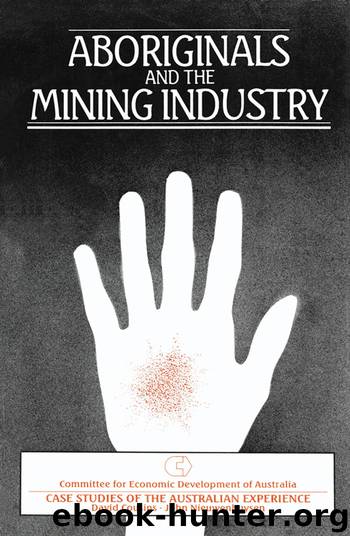Aboriginals and the Mining Industry by David Cousins

Author:David Cousins
Language: eng
Format: epub
Tags: Australian Aborigines
Publisher: Allen & Unwin Pty Ltd
Published: 1983-12-31T16:00:00+00:00
The development of mining in the region was to proceed in the context of a total land-use plan, including establishment of the Kakadu National Park (the mining lease areas are excluded from the park), the recognition of Aboriginal ownership of the land, and the construction of the Jabiru township.
The decision to establish a national park was recognition of the need to preserve the unique features of the region for future generations. The park has a wide variety of landscape, vegetation and wildlife types not found elsewhere in Australia. It includes parts of the Arnhem Land plateau and escarpment, flood plains, permanent lagoons, swamps and major tidal river systems. It also contains Aboriginal sacred sites, sites of archaeological significance, and an unequalled assembage of Aboriginal rock paintings. The National Park was considered reasonably consonant with the lifestyle of the local Aboriginal people, and was supported by them. It was suggested that the park would provide suitable job opportunities and generally act as a buffer to prevent excessive intrusion.8
Under the 1976 Land Rights Act Aboriginals gained freehold title to most of the region. Titles to the Arnhem Land and Woolwonga Aboriginal reserves were vested in Aboriginal land trusts. The government also accepted the Fox recommendation that certain unalienated land (including both the Ranger and Koongarra uranium deposits, but excluding the Jabiru town site) should be granted to Aboriginals. By an agreement between the NLC and the Australian National Parks and Wildlife Service (ANPWS) this area has been incorporated in the Kakadu National Park (Stage 1). In effect, the Aboriginal people have leased this to the nation. A plan of management for the park, severely criticised by some commentators for not effectively involving the Aboriginal owners in the decision-making structure,9 has been adopted.
Further, the government agreed to purchase the Mudginberri and Munmarlary pastoral leases. These became subject to an Aboriginal land claim, under Section 50 of the 1976 Land Rights Act. The Aboriginal Land Commissioner, Mr Justice Toohey, found that the traditional attachment of the Aboriginal owners to a portion of this land was strong and agreed with their claim to the area.10 Aboriginal claims to this land were actively supported by Pancontinental Mining Limited (PANCON) although it incorporates the Jabiluka uranium deposit.
Minerals on Aboriginal land remain the property of the Crown, but Aboriginal consent is normally required before exploration and mining can begin. The Act specifically exempts from this requirement three areas where mining companies held rights and had applied for other interests before 4 June 1976; the Alligator Rivers region, the Ranger project area and the eastern parts of Groote Eylandt. (A national interest clause may also be envoked if consent is withheld in other areas.) Consequently, Aboriginal consent was not required for uranium mining to proceed, but three agreements have been negotiated over mining terms by the NLC, on behalf of traditional land owners. The first on the Ranger deposit was signed by the commonwealth on behalf of the joint venture partners in November 1978.11 Queensland Mines Ltd (QML) and PANCON also signed agreements with the NLC (in March 1979 and July 1982 respectively).
Download
This site does not store any files on its server. We only index and link to content provided by other sites. Please contact the content providers to delete copyright contents if any and email us, we'll remove relevant links or contents immediately.
| Africa | Americas |
| Arctic & Antarctica | Asia |
| Australia & Oceania | Europe |
| Middle East | Russia |
| United States | World |
| Ancient Civilizations | Military |
| Historical Study & Educational Resources |
The Memory Code by Lynne Kelly(2277)
Schindler's Ark by Thomas Keneally(1763)
Kings Cross by Louis Nowra(1682)
Burke and Wills: The triumph and tragedy of Australia's most famous explorers by Peter Fitzsimons(1310)
The Falklands War by Martin Middlebrook(1297)
1914 by Paul Ham(1271)
Code Breakers by Craig Collie(1181)
Paradise in Chains by Diana Preston(1175)
Burke and Wills by Peter FitzSimons(1170)
Watkin Tench's 1788 by Flannery Tim; Tench Watkin;(1166)
A Farewell to Ice: A Report from the Arctic by Peter Wadhams(1160)
The Secret Cold War by John Blaxland(1154)
The Protest Years by John Blaxland(1120)
30 Days in Sydney by Peter Carey(1082)
The Lucky Country by Donald Horne(1076)
Lucky 666 by Bob Drury & Tom Clavin(1066)
THE LUMINARIES by Eleanor Catton(1063)
The Land Before Avocado by Richard Glover(1046)
Not Just Black and White by Lesley Williams(1013)
